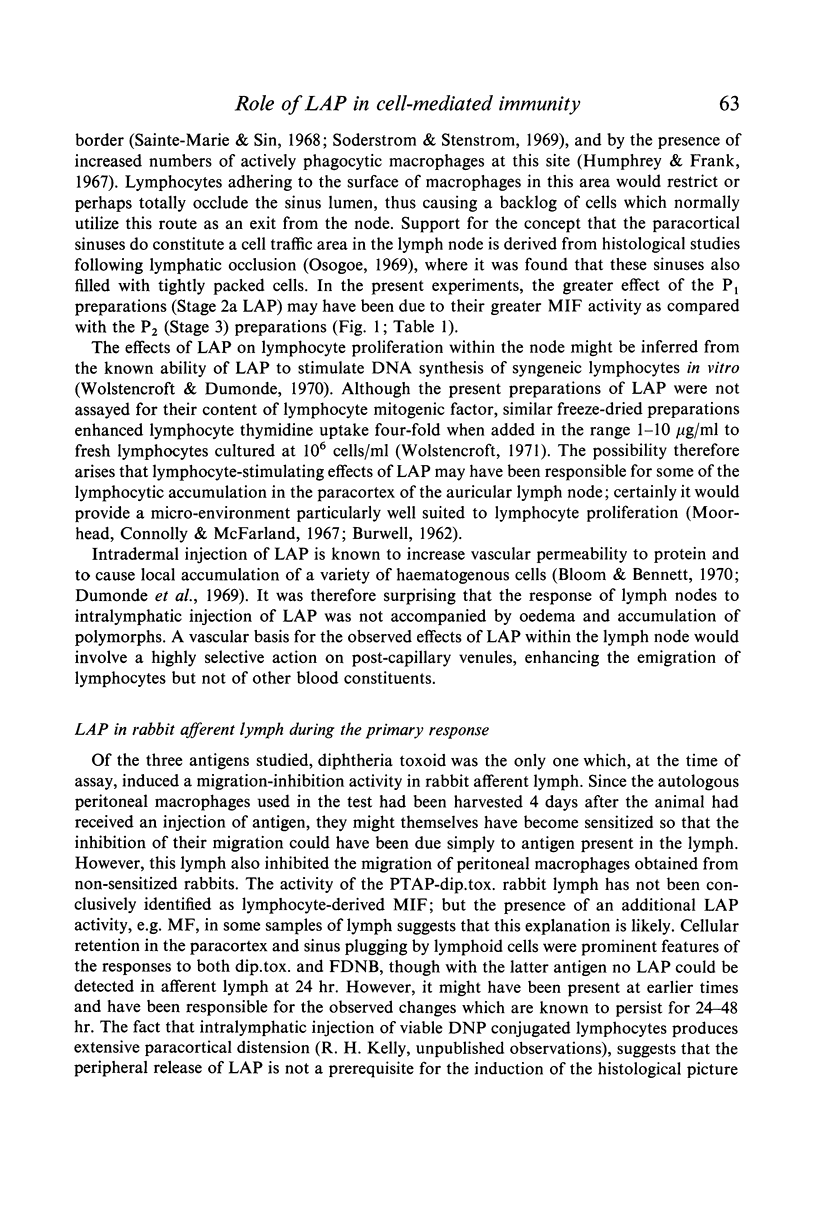Abstract
The experiments reported here were concerned with determining the effects of lymphocyte activation products (LAP) on lymph node architecture, and with assaying afferent lymph for evidence of the peripheral release of LAP during the induction of an immune response.
Intralymphatic inoculation of purified homologous LAP into guinea-pigs resulted in increased weight and cellular content of the draining node. Histologically these nodes showed paracortical distension and dense aggregations of lymphoid cells or `cellular plugs' in the paracortical sinuses. It was suggested that one effect of LAP may be to cause cellular retention in the paracortex of lymph nodes by regulating the rate of cell exit via the sinuses of the node.
The peripheral lymph of rabbits was assayed for its ability to inhibit macrophage migration and to accelerate lymphocyte DNA synthesis after stimulation with three different antigens. The antigens were chosen to give a spectrum which ranged from a primarily humoral response (erythrocyte stimulation) through a mixed humoral and cell-mediated response (diphtheria toxoid stimulation) to a predominantly cell-mediated type of response (skin contact sensitization to fluorodinitrobenzene–FDNB). Paracortical distension with lymphoid cell sinus plugging, similar to that observed in the guinea-pig nodes following intralymphatic injection of LAP, were common features of both the diphtheria toxoid and FDNB responses. It was concluded that the development of this type of sinus plugging and paracortical distension might be related to multiple activities of LAP generated and released either at the peripheral antigen depot or within the draining node.
Full text
PDF
















Images in this article
Selected References
These references are in PubMed. This may not be the complete list of references from this article.
- ADA G. L., NOSSAL G. J., PYE J., ABBOT A. BEHAVIOUR OF ACTIVE BACTERIAL ANTIGENS DURING THE INDUCTION OF THE IMMUNE RESPONSE. I. PROPERTIES OF FLAGELLAR ANTIGENS FROM SALMONELLA. Nature. 1963 Sep 28;199:1257–1259. doi: 10.1038/1991257a0. [DOI] [PubMed] [Google Scholar]
- BURWELL R. G. Studies of the primary and the secondary immune responses of lymph nodes draining homografts of fresh cancellous bone (with particular reference to mechanisms of lymph node reactivity). Ann N Y Acad Sci. 1962 Oct 24;99:821–860. doi: 10.1111/j.1749-6632.1962.tb45365.x. [DOI] [PubMed] [Google Scholar]
- Bartfeld H., Kelly R. Mediation of delayed hypersensitivity by peripheral blood lymphocytes in vitro and by their products in vivo and in vitro, morphology of in vitro lymphocyte-macrophage interaction. J Immunol. 1968 May;100(5):1000–1005. [PubMed] [Google Scholar]
- Bloom B. R., Bennett B. Relation of the migration inhibitory factor (MIF) to delayed-type hypersensitivity reactions. Ann N Y Acad Sci. 1970 Feb 13;169(1):258–265. doi: 10.1111/j.1749-6632.1970.tb55994.x. [DOI] [PubMed] [Google Scholar]
- Bryceson A. D., Bray R. S., Wolstencroft R. A., Dumonde D. C. Immunity in cutaneous leishmaniasis of the guinea-pig. Clin Exp Immunol. 1970 Sep;7(3):301–341. [PMC free article] [PubMed] [Google Scholar]
- Dresser D. W., Taub R. N., Krantz A. R. The effect of localized injection of adjuvant material on the draining lymph node. II. Circulating lymphocytes. Immunology. 1970 May;18(5):663–670. [PMC free article] [PubMed] [Google Scholar]
- Dumonde D. C., Page D. A., Matthew M., Wolstencroft R. A. Role of lymphocyte activation products (LAP) in cell-mediated immunity. I. Preparation and partial purification of guinea-pig LAP. Clin Exp Immunol. 1972 Jan;10(1):25–47. [PMC free article] [PubMed] [Google Scholar]
- Dumonde D. C., Wolstencroft R. A., Panayi G. S., Matthew M., Morley J., Howson W. T. "Lymphokines": non-antibody mediators of cellular immunity generated by lymphocyte activation. Nature. 1969 Oct 4;224(5214):38–42. doi: 10.1038/224038a0. [DOI] [PubMed] [Google Scholar]
- Godal T., Rees R. J., Lamvik J. O. Lymphocyte-mediated modification of blood-derived macrophage function in vitro; inhibition of growth of intracellular mycobacteria with lymphokines. Clin Exp Immunol. 1971 Apr;8(4):625–637. [PMC free article] [PubMed] [Google Scholar]
- HALL J. G., MORRIS B. The lymph-borne cells of the immune response. Q J Exp Physiol Cogn Med Sci. 1963 Jul;48:235–247. doi: 10.1113/expphysiol.1963.sp001660. [DOI] [PubMed] [Google Scholar]
- Humphrey J. H., Frank M. M. The localization of non-microbial antigens in the draining lymph nodes of tolerant, normal and primed rabbits. Immunology. 1967 Jul;13(1):87–100. [PMC free article] [PubMed] [Google Scholar]
- Kelly R. H. Localization of afferent lymph cells within the draining node during a primary immune response. Nature. 1970 Aug 1;227(5257):510–513. doi: 10.1038/227510a0. [DOI] [PubMed] [Google Scholar]
- Mooney J. J., Waksman B. H. Activation of normal rabbit macrophage monolayers by supernatants of antigen-stimulated lymphocytes. J Immunol. 1970 Nov;105(5):1138–1145. [PubMed] [Google Scholar]
- Moorhead J. F., Connolly J. J., McFarland W. Factors affecting the reactivity of human lymphocytes in vitro. I. Cell number, duration of culture and surface area. J Immunol. 1967 Aug;99(2):413–419. [PubMed] [Google Scholar]
- Osogoe B. Changes in the cellular architecture of a lymph node after blocking its lymphatic circulation. J Anat. 1969 May;104(Pt 3):495–506. [PMC free article] [PubMed] [Google Scholar]
- Osogoe B., Courtice F. C. The effects of occlusion of the blood supply to the popliteal lymph node of the rabbit on the cell and protein content of the lymph and on the histology of the node. Aust J Exp Biol Med Sci. 1968 Oct;46(5):515–524. doi: 10.1038/icb.1968.159. [DOI] [PubMed] [Google Scholar]
- Sainte-Marie G., Sin Y. M. Structures of the lymph node and their possible function during the immune response. Rev Can Biol. 1968 Sep;27(3):191–207. [PubMed] [Google Scholar]
- Söderström N., Stenström A. Outflow paths of cells from the lymph node parenchyma to the efferent lymphatics--observations in thin section histology. Scand J Haematol. 1969;6(3):186–196. doi: 10.1111/j.1600-0609.1969.tb01825.x. [DOI] [PubMed] [Google Scholar]
- Wolstencroft R. A., Dumonde D. C. In vitro studies of cell-mediated immunity. I. Induction of lymphocyte transformation by a soluble "mitogenic" factor derived from interaction of sensitized guinea-pig lymphoid cells with specific antigen. Immunology. 1970 Apr;18(4):599–610. [PMC free article] [PubMed] [Google Scholar]
- de Sousa M. A., Parrott D. M. Induction and recall in contact sensivitity. Changes in skin and draining lymph nodes of intact and thymectomized mice. J Exp Med. 1969 Oct 1;130(4):671–690. doi: 10.1084/jem.130.4.671. [DOI] [PMC free article] [PubMed] [Google Scholar]






